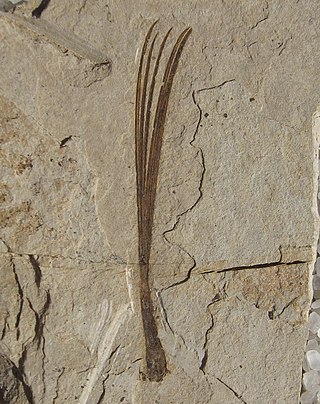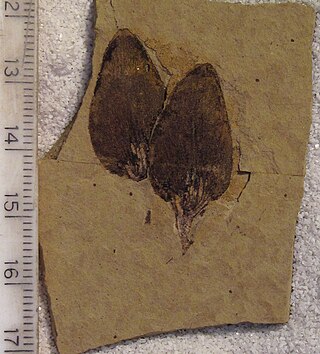
Pinus ponderosa, commonly known as the ponderosa pine, bull pine, blackjack pine, western yellow-pine, or filipinus pine, is a very large pine tree species of variable habitat native to mountainous regions of western North America. It is the most widely distributed pine species in North America.

Peltandra, the arrow arums, is a genus of plants in the family Araceae. It is native to the eastern United States, eastern Canada, and Cuba.
- Peltandra sagittifolia - (Michx.) Morong - Spoon flower or the white arrow arum - southeastern US from eastern Louisiana to Virginia
- Peltandra virginica(L.) Schott - Arum arrow - Cuba, Quebec, Ontario, Oregon, California, Washington; eastern US from Maine to Florida, west to Texas, Kansas, and Minnesota
- †Peltandra primaeva – Eocene, Golden Valley Formation, North Dakota, USA

The Paskapoo Formation is a stratigraphic unit of Middle to Late Paleocene age in the Western Canada Sedimentary Basin. The Paskapoo underlies much of southwestern Alberta, and takes the name from the Blindman River. It was first described from outcrops along that river, near its confluence with the Red Deer River north of the city of Red Deer, by Joseph Tyrrell in 1887. It is important for its freshwater aquifers, its coal resources, and its fossil record, as well as having been the source of sandstone for the construction of fire-resistant buildings in Calgary during the early 1900s.
Peltandra primaeva is an extinct species of monocot in the family Araceae known from a Ypresian age Eocene fossil found in western North Dakota, USA.
Nelumbo aureavallis is an extinct species of flowering plants in the lotus family known from Ypresian age Eocene fossils found in western North Dakota, USA.
Acer alaskense is an extinct maple species in the family Sapindaceae described from a fossil leaf. The species is solely known from the Latest Paleocene sediments exposed in the Matanuska River Valley, Matanuska-Susitna Borough, Alaska. It is the type species for the extinct section Alaskana.
Acer hillsi is an extinct maple species in the family Sapindaceae described from a single fossil samara. The species is solely known from the Early Eocene sediments exposed in northeast Washington state, United States and the adjacent area of south central British Columbia, Canada. It is one of only two species belonging to the extinct section Stewarta.
Acer stewarti is an extinct maple species in the family Sapindaceae described from a series of fossil leaves and samaras. The species is solely known from the Early Eocene sediments exposed in south central British Columbia, Canada adjacent to northeast Washington state, United States. It is one of only two species belonging to the extinct section Stewarta.
Acer browni is an extinct maple species in the family Sapindaceae described from a series of isolated fossil leaves and samaras. The species is known from the early to middle Miocene sediments exposed in Western Oregon, Washington state, USA and Northern Graham Island, Haida Gwaii, Canada. It is one of several extinct species placed in the living section Parviflora.
Acer clarnoense is an extinct maple species in the family Sapindaceae described from a series of isolated fossil leaves and samaras. The species is known from the late Eocene sediments exposed in the state of Oregon in the US. It is one of several extinct species placed in the living section Macrantha.

Ginkgo cranei is an extinct Ginkgo species in the family Ginkgoaceae described from a series of isolated fossil ovulate organs and leaves. The species is known from upper Paleocene sediments exposed in the state of North Dakota, US. It is the first Ginkgo species to be described from Paleogene period with reproductive structures.
Cornus piggae is an extinct species of dogwood known from fossil fruits found in Late Paleocene sediments exposed in the US state of North Dakota. C. piggae is one of three extinct species placed in the Cornus subgenus Cornus based on fossil fruit morphology. The other two species, C. ettingshausenii and C. multilocularis are known from pyritized fruits found in sediments of the London Clay in England. C. piggae is the only North American fruit species yet described and is also the oldest described species in Cornus subgenus Cornus.
Acer traini is an extinct maple species in the family Sapindaceae described from isolated fossil samaras. The species was described from Miocene-aged fossils found in Canada and the United States of America. It is one of several extinct species placed in the living section Glabra.
The Golden Valley Formation is a stratigraphic unit of Late Paleocene to Early Eocene age in the Williston Basin of North Dakota. It is present in western North Dakota and was named for the city of Golden Valley by W.E. Benson and W.M. Laird in 1947. It preserves significant assemblages of fossil plants and vertebrates, as well as mollusk and insect fossils.

Glyptostrobus europaeus is an extinct conifer species of the family Cupressaceae that is found as fossils throughout the Northern Hemisphere. The sole living species of Glyptostrobus was described from China in 1926. The name of the genus comes from the Greek "glypto" meaning grooved or carved, and "strobilus" meaning cone. The species name "europaeus" refers to the fact that it was first described from Europe.

Pinus latahensis is an extinct species of conifer in the pine family Pinaceae. The species is known from fossil leaves found in the early Eocene deposits of northern Washington state, United States, and southern British Columbia, Canada.

Pseudolarix wehrii is an extinct species of golden larch in the pine family (Pinaceae). The species is known from early Eocene fossils of northern Washington state, United States, and southern British Columbia, Canada, along with late Eocene mummified fossils found in the Qikiqtaaluk Region, Nunavut, Canada.
Acer spitzi is an extinct maple species in the family Sapindaceae described from a single fossil samara. The species is solely known from the Early Eocene sediments exposed in northeast Washington state, United States. It is the only species belonging to the extinct section Spitza.

Pteronepelys, sometimes known as the winged stranger, is an extinct genus of flowering plant of uncertain affinities, which contains the one species, Pteronepelys wehrii. It is known from isolated fossil seeds found in middle Eocene sediments exposed in north central Oregon and Ypresian-age fossils found in Washington, US.







